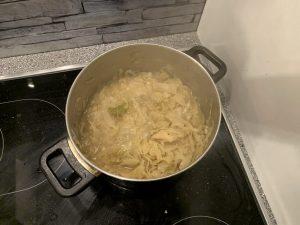 … the traditional german way – or not?
… the traditional german way – or not?
Sauerkraut is so german it even gave us our name 🙂 , it’s very widespread in the nation, very regionally diverse and versatile. It is part of the traditional german cuisine, mostly eaten as a side dish but also as a full meal when made with the appropriate ingredients. It’ very healthy – for example for it’s contents of vitamin C which even increases when cooked.
There’s what feels like a gazillion ways of preparing (especially homemade) Sauerkraut in germany alone (and I bet there are even more recipes all over the world). To condense these down to some kind of a standard formula that everything else can be built upon, here’s my way. BTW: We’re talking fresh and unprocessed Sauerkraut here, not the pre-cooked, canned version from the supermarket.
My personal absolutely basic sauerkraut recipe:
(Variations and recommendations at the end)
500 g frisches Sauerkraut
1 tbsp. butter *
1 medium onion
500 ml vegetable stock **
2 bay leaves ***
1 tsp. peppercorns ***
Pinch of sugar
Salt
Method:
Dice the onion and melt the butter (see annotations) in large pot and saute the onions until they’re translucent. Variation: At this point you might also want to add some diced bacon.
Prepare the broth or stock (see annotations). Add the stock to the pot and let it come to a boil. Once boiling add the kraut and your seasoning(s) (see annotations) and stir well.
Let this simmer, covered, at a medium-low heat for up to 45 mins. depending on how soft you like your sauerkraut. Variation: Add kassler or speck (see additions) right from the beginning, or suitable sausages (see additions) 15 – 20 mins. before the end of the cooking time.
Finally taste-test, season with salt if needed and serve.
Annotations:
* May/should/must be substituted by either pork lard or clarified butter
** Other variations: White wine, beef stock, beer, even some apple juice or a mixture of several of them
*** Additional spices might be juniper, caraway, fennel seeds, cloves or sugar
Possible Additions:
Some bind the kraut with a little rasped potato they cook along, or with a little roux.
Rasped apples or pears are popular in some regions.
Meaty additions are: Speck, Kassler , etc.
Common sausage additions are Pinkel, Grützwurst or Kochwurst
(The above are variations from different regions of germany, try your own!)
